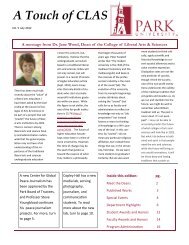How to Write a Radio Serial Drama for Social Development- PDF
How to Write a Radio Serial Drama for Social Development- PDF
How to Write a Radio Serial Drama for Social Development- PDF
Create successful ePaper yourself
Turn your PDF publications into a flip-book with our unique Google optimized e-Paper software.
xviii Prologue<br />
aware that it is possible <strong>to</strong> protect their children from disease through immunization and that<br />
immunization requires treatment by a health worker. Parents also need <strong>to</strong> know where and when<br />
<strong>to</strong> obtain such treatment. Without this basic awareness and knowledge, parents are unlikely <strong>to</strong><br />
take their children <strong>for</strong> immunization. Some behaviors require more complicated and detailed<br />
knowledge than others. For example, providing a nutritious diet <strong>for</strong> a family <strong>for</strong> a year is a more<br />
complex behavior, requiring more knowledge, than treating a child <strong>for</strong> a single bout with diarrhea.<br />
Some apparently simple behaviors actually are quite complicated. For example, the knowledge<br />
needed <strong>to</strong> put on a condom correctly is fairly simple, but the knowledge required <strong>to</strong> negotiate<br />
condom use with a sexual partner is far more complicated. The design team must provide within<br />
the <strong>Write</strong>r’s Brief the right kind of knowledge and the appropriate level of detail <strong>to</strong> guide the<br />
writer with regard <strong>to</strong> message content within the s<strong>to</strong>ry. (Chapter 2 discusses the contents of the<br />
<strong>Write</strong>r’s Brief.)<br />
2. Approval refers <strong>to</strong> favorable attitudes <strong>to</strong>ward the behavior being promoted. People who approve<br />
of a behavior talk about it with others and tend <strong>to</strong> think that other people approve of it as well.<br />
Approval can occur at several levels: Listeners may approve of a new behavior <strong>for</strong> people in<br />
general, <strong>for</strong> friends and family, and/or <strong>for</strong> themselves personally. Some listeners may approve of<br />
the behavior <strong>for</strong> others, but not <strong>for</strong> themselves. <strong>Serial</strong> drama can include a range of role-model<br />
characters who depict public approval of a behavior, express positive emotional reactions <strong>to</strong>ward a<br />
behavior, or show how personal attitudes respond <strong>to</strong> public approval.<br />
3. Intention <strong>to</strong> act. The more strongly people approve of a behavior, the more likely it is that they<br />
will <strong>for</strong>m an intention <strong>to</strong> act. Intention is the stage just prior <strong>to</strong> action; recognizing that the<br />
behavior fills a personal need, the person has decided <strong>to</strong> try it, but not yet changed his or her<br />
behavior. Intention does not mean that the behavior will occur always or immediately. There are<br />
degrees of intention (definitely, probably, maybe), and intention can be conditional (“I won’t take<br />
her <strong>to</strong>day, but if her fever doesn’t go down by <strong>to</strong>morrow, I will definitely take her <strong>to</strong> the doc<strong>to</strong>r<br />
then”). The design team must identify the personal needs of the listeners that are likely <strong>to</strong><br />
motivate their intentions <strong>to</strong> act and the conditions that make such intentions more likely.<br />
4. Practice is the actual per<strong>for</strong>mance of a behavior. People with a high degree of intention are the<br />
most likely actually <strong>to</strong> per<strong>for</strong>m a behavior. Practice need not imply confirmed or consistent<br />
behavior, however. Some people try a behavior and then reject it. Others start, s<strong>to</strong>p, and start<br />
again. People who per<strong>for</strong>m a behavior intermittently may have experienced unexpected or<br />
unpleasant consequences or may require support or rein<strong>for</strong>cement <strong>for</strong> their behavior. The <strong>Write</strong>r’s<br />
Brief should include a description of the possible change agents that will motivate the audience <strong>to</strong><br />
try a behavior and <strong>to</strong> persist with it. There should be recognition, also, of the likely pattern of<br />
adoption. Do members of the audience generally stick with a behavior once they try it, or do they<br />
tend <strong>to</strong> start and s<strong>to</strong>p a lot be<strong>for</strong>e practicing a new behavior consistently <strong>Radio</strong> scripts can model<br />
a variety of ways in which people eventually practice a behavior.<br />
5. Advocacy, the final step <strong>to</strong> behavior change, is a vital part of the process because it represents a<br />
level of commitment that goes beyond the mere practice of a new behavior. Advocates tell other<br />
people about the behavior they have adopted and encourage them <strong>to</strong> adopt it, <strong>to</strong>o. At the same<br />
time, talking <strong>to</strong> others can strengthen the advocate’s own resolve <strong>to</strong> continue with a difficult<br />
behavior. Advocacy also allows people <strong>to</strong> express community support <strong>for</strong> a social change program.<br />
Such public expressions of support <strong>for</strong> a behavior can move people through the steps <strong>to</strong> behavior<br />
change, making them aware of a behavior (knowledge), increasing their perception of public<br />
support <strong>for</strong> a behavior (approval), motivating them <strong>to</strong> make a decision <strong>to</strong> act (intention), and<br />
encouraging them <strong>to</strong> implement that decision (practice).
















